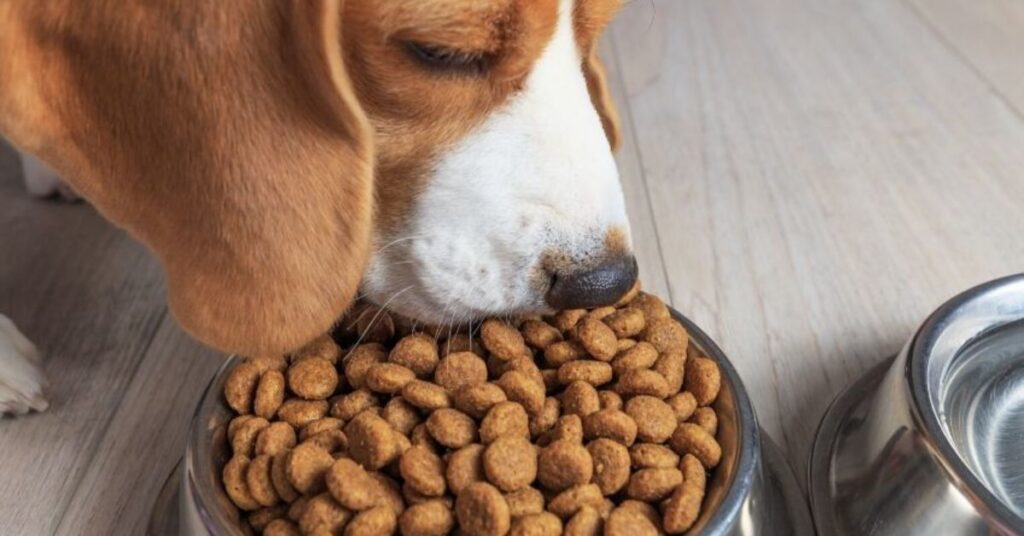As pet parents, one of the most important decisions you can make is ensuring your dog’s diet meets their nutritional needs. Among the key macronutrients, protein stands out as essential for a dog’s overall health and well-being.
But how much protein does a dog really need per pound of body weight? And what happens if they get too much or too little?
In this article, we’ll discuss the science behind protein, explain exactly how much your dog needs, and dive into factors like age, breed, and health that can influence your dog’s protein requirements.
What is Protein and What Does it Do for Dogs?

Protein is often referred to as the “building block” of life, and that’s no exaggeration. It plays a crucial role in just about every biological process in your dog’s body. Protein is made up of amino acids, which are compounds used to build muscle, repair tissue, produce enzymes, and support the immune system.
When a dog eats protein from their pet food, their body breaks it down into amino acids. These amino acids are then used to perform critical functions such as:
- Building muscles and supporting growth
- Maintaining a healthy coat and skin
- Repairing tissues and healing wounds
- Producing enzymes for digestion and metabolic activities
- Supporting the immune system to fight infections and diseases
Dogs require essential amino acids, which they can’t produce on their own, so it’s vital these come from their dog food. Without enough protein and essential amino acids, a dog’s body can’t perform at its best.
So, Exactly How Much Protein Does a Dog Need Per Pound of Body Weight?
Pet parents often wonder if there’s a simple formula to figure out how much protein their dog needs. And the good news is, there is a general guideline: dogs typically need about 1 gram of protein per pound of body weight every day.
For example:
- A 40-pound dog would need roughly 40 grams of protein daily.
- A 20-pound dog would need about 20 grams of protein.
However, this is just a baseline. Factors like age, breed, and activity level can significantly impact your dog’s protein needs. For example:
- Puppies require more protein to support their growth, often needing 22-25% of their diet to be protein.
- Senior dogs may require less, though it’s still important to include high-quality protein sources to prevent muscle loss.
- Active dogs like working or sporting breeds may need more than the standard recommendation to help repair and build muscles.
What Other Factors Affect How Much Protein a Dog Needs?
While dog’s protein needs are commonly measured by body weight, several other factors influence the amount and quality of protein your dog should get. Here are some key factors to consider:
Age
- Puppies and young dogs require more protein for growth and development. Crude protein content in puppy foods often ranges from 22-29% to support this rapid growth phase.
- Adult dogs, especially those in their prime, typically need 18-25% protein in their diet to maintain muscle and overall health.
- Senior dogs may benefit from slightly lower protein levels, particularly if they have kidney issues, but should still get quality amino acids from their diet.
Activity Level
- Active or working dogs (e.g., herding or hunting dogs) may require more protein to support energy needs and muscle recovery.
- Couch potatoes or dogs with low activity levels generally need less protein but still benefit from high-quality amino acids to maintain lean body mass.
Health Conditions
Certain health issues may require adjustments to a dog’s protein intake. For example:
- Dogs with chronic kidney disease (CKD) often need a lower protein content to reduce strain on the kidneys.
- Dogs recovering from surgery or illness might need high protein diets to support healing.
Breed
Some breeds, such as Greyhounds or Dobermans, have higher metabolisms and may benefit from slightly higher protein content in their diet.
Now Fresh Dry Food Recipes for Dogs
One excellent choice for ensuring your dog gets the right amount of protein is Now Fresh Dry Food recipes. These foods feature fresh meats like turkey, salmon, and duck as the primary protein sources. Since these recipes focus on using fresh meats rather than fillers or meat meals, they provide your dog with amino acids that are easily digestible.
Here’s why Now Fresh Dry Food is a great option:
- High-quality proteins from real fresh meats, not by-products or meat meals.
- Balanced essential nutrients for different life stages and sizes.
- No fillers like corn or soy, which can dilute the protein content.
What Happens With Excess Protein?

Excess protein in a dog’s diet isn’t always harmful, but it depends on the individual dog’s health and needs. When a dog consumes more protein than it needs, the body will convert the extra protein into energy. However, if this energy isn’t used, it can lead to fat storage and weight gain.
For healthy dogs, excess protein is typically excreted in the urine. This process occurs through the liver, which breaks down amino acids into waste products like urea. Over time, feeding too much protein can stress the liver and kidneys, particularly in older dogs or those with health conditions.
What About High Protein Diets?
High protein diets have gained popularity in recent years, particularly for active or working dogs. These diets can be beneficial in specific scenarios:
- Athletic or working dogs that need more energy and muscle recovery.
- Dogs recovering from injury or surgery that require extra protein to heal.
- Senior dogs experiencing muscle loss, where additional amino acids can help maintain lean muscle mass.
However, there are also potential downsides to feeding high protein diets to less active dogs or those with kidney problems. Always consult your vet before making drastic changes to your dog’s protein intake.
The Numbers
Here’s a general guide to protein content based on life stage and activity level:
| Dog Type | Protein % in Diet (Approx.) |
| Puppies | 22-25% |
| Adult dogs (average) | 18-25% |
| Senior dogs | 18-21% |
| Active or working dogs | 25-30% |
| Dogs with kidney issues | 15-18% |
These percentages apply to both dry dog food and wet food options. Always check the pet food label for crude protein percentage.
Where is Protein Found?
When it comes to pet food, not all protein sources are created equal. It’s important to know where the protein in your dog’s food comes from and how it contributes to the overall amino acid content.
Common protein sources include:
- Fresh meats: Chicken, turkey, beef, fish
- Meat meals: Concentrated proteins made from rendered meats
- Plant-based proteins: Peas, lentils, chickpeas (often found in grain-free diets)
- Eggs: A highly digestible protein source with a complete profile of essential amino acids
For the best quality, look for pet food where fresh meats are listed as the primary ingredient. Meat meals can still be a good source of protein, but they are often less digestible than fresh meats.
How to Add More Protein
If your dog needs more protein, here are a few easy ways to increase their intake:
- Switch to a high-protein dog food: Look for pet food with at least 25% crude protein, preferably from fresh meats.
- Add cooked lean meats: Chicken, turkey, or beef can be added to your dog’s existing food for a boost of amino acids.
- Eggs: Eggs are a great source of protein and can be added to your dog’s meal (cooked, not raw).
- Protein supplements: Consult your vet for recommendations on safe and effective protein supplements.
What Are the Side Effects of Too Much Unused Protein?
While protein is critical, too much unused protein can lead to several issues, including:
- Weight gain: Extra protein can be stored as fat if not burned off.
- Kidney strain: Dogs with kidney disease should avoid high protein diets to reduce kidney workload.
- Digestive issues: Too much protein can lead to diarrhea or an upset stomach.
In healthy dogs, most excess protein will simply be excreted, but it’s always best to avoid overfeeding protein unless your dog has high energy needs.
Quality Over Quantity
When it comes to protein in your dog’s diet, quality is more important than quantity. High-quality protein sources come from fresh meats and provide a complete profile of essential amino acids. On the other hand, lower-quality proteins from fillers like soy or generic meat meals may not deliver the same benefits.
Here are some tips to ensure you’re feeding your dog the best possible protein:
- Look for named protein sources like “chicken” or “beef” instead of vague terms like “meat meal.”
- Prioritize fresh meats over heavily processed ingredients.
- Check the amino acid content to ensure your dog is getting a balanced profile of essential nutrients.
Call to Action: Explore Now Fresh Dry Food recipes, which feature fresh meats and provide balanced protein content for dogs at every life stage. This ensures your dog gets the best protein for optimal health.
Conclusion
Knowing how much protein your dog needs per pound of body weight is key to keeping them healthy and active. Whether you’re feeding a puppy or an older dog, balancing the right amount of protein with high-quality protein sources can make a significant difference in your dog’s overall health. Pay attention to their activity level, age, and any health conditions, and consult with your vet to ensure you’re feeding your dog what they need.
When in doubt, opt for high-quality pet food that lists fresh meats as the primary ingredient, and always prioritize essential amino acids over just increasing the crude protein content.
Frequently Asked Questions
How much protein does my dog need per pound of body weight?
On average, dogs need about 1 gram of protein per pound of body weight daily, but factors like age, breed, and activity level can change this.
Can too much protein harm my dog?
Yes, excess protein can lead to weight gain or put strain on the kidneys, especially in dogs with kidney issues.
What are the best sources of protein for dogs?
Fresh meats like chicken, beef, and fish are the best sources of high-quality protein with complete amino acids.
Should puppies have more protein than adult dogs?
Yes, puppies need more protein to support their rapid growth, typically around 22-25% of their diet.
Can I add more protein to my dog’s food?
Yes, you can add lean cooked meats, eggs, or switch to a high-protein dog food to increase their protein intake.
>>>Read more:

